必修三unit1 grammarb3u1 语法
- 格式:ppt
- 大小:8.24 MB
- 文档页数:42
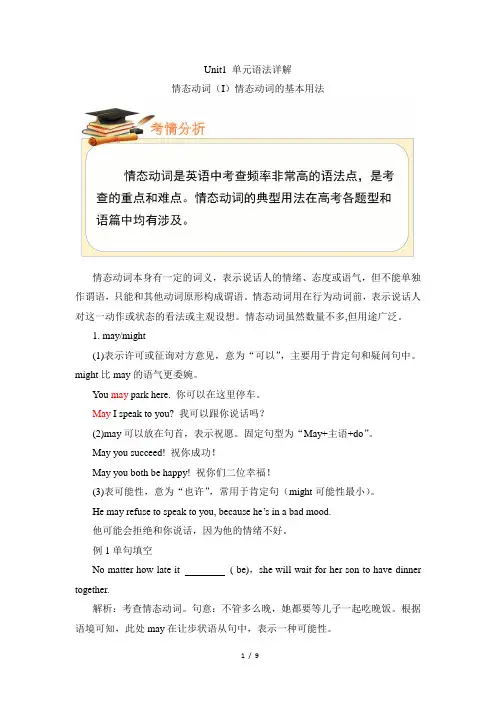
Unit1 单元语法详解情态动词(I)情态动词的基本用法情态动词本身有一定的词义,表示说话人的情绪、态度或语气,但不能单独作谓语,只能和其他动词原形构成谓语。
情态动词用在行为动词前,表示说话人对这一动作或状态的看法或主观设想。
情态动词虽然数量不多,但用途广泛。
1. may/might(1)表示许可或征询对方意见,意为“可以”,主要用于肯定句和疑问句中。
might比may的语气更委婉。
You may park here. 你可以在这里停车。
May I speak to you? 我可以跟你说话吗?(2)may可以放在句首,表示祝愿。
固定句型为“May+主语+do”。
May you succeed! 祝你成功!May you both be happy! 祝你们二位幸福!(3)表可能性,意为“也许”,常用于肯定句(might可能性最小)。
He may refuse to speak to you, because he’s in a bad mood.他可能会拒绝和你说话,因为他的情绪不好。
例1单句填空No matter how late it ( be),she will wait for her son to have dinner together.解析:考查情态动词。
句意:不管多么晚,她都要等儿子一起吃晚饭。
根据语境可知,此处may在让步状语从句中,表示一种可能性。
答案:may be2. can/could(1)表示具备某种能力,常译作“能”、“会”。
could主要指过去能做。
Can you play the piano? 你会弹钢琴吗?He could speak English when he was a child.当他是个孩子的时候他就会说英语。
(2)表示提出请求或征求许可。
could用于疑问句中表示委婉语气,但不用于答语中。
Can/Could I smoke here? 我可以在这里吸烟吗?(3 ) can可用于肯定句中,表示常有的行为和情形,意为“有时会,时而可能”。
![新人教必修3_Unit1_Grammar情态动词]](https://uimg.taocdn.com/35b7c822453610661ed9f4a7.webp)

高中英语必修三第一单元语法总结
高中英语必修三第一单元语法总结
第一单元
语法·剖析
Ⅰ.形容词修饰名词的先后顺序
本课中出现了许多如“the most handsome rooster” “the most energetic and important festivals” “an important religious and social festival” 等短语,这些名词性的短语中都含有两个甚至更多的修饰词,那么如何来安排他们的顺序呢?通常根据它们与名词间的关系疏密来确定先后顺序,关系越密切,就越靠近名词;表示主观看法的形容词要比表示客观特征的形容词离该名词远些;形容词意义相近时,音节少的置前,音节多的置后。
为了便于记忆,特编写一首顺口溜帮你轻松掌握。
形容词修饰名词的先后顺序顺口溜:
县官行令宴国才,好美小高转其新,彩色国料特别近。
顺口溜
解释
例词
限(县)
限定词,指冠词、指示代词、形容词性物主代词、(先)序数词、(后)基数词等
a(n),the ,this ,several ,their ,first ,three ,other
观(官)
外观词,指描绘性形容词(多表主观看法)
Beautiful ,fine ,pretty
形(行)
形状词,指大小、长短、高低、方圆等
Big ,long ,short ,round
龄(令)
年龄词,指新、旧等
Old ,young ,new
颜(宴)。
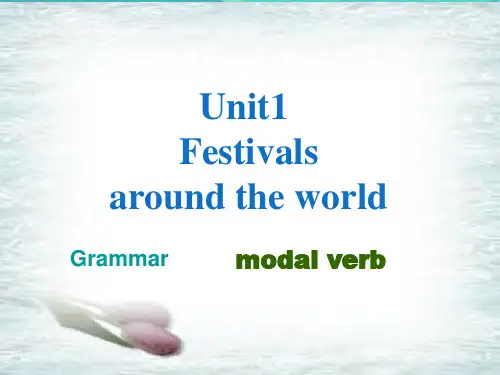
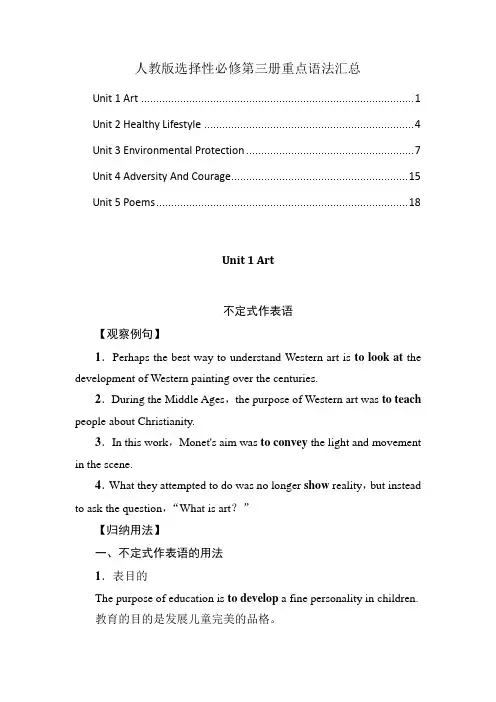
人教版选择性必修第三册重点语法汇总Unit 1 Art (1)Unit 2 Healthy Lifestyle (4)Unit 3 Environmental Protection (7)Unit 4 Adversity And Courage (15)Unit 5 Poems (18)Unit 1 Art不定式作表语【观察例句】1.Perhaps the best way to understand Western art is to look at the development of Western painting over the centuries.2.During the Middle Ages,the purpose of Western art was to teach people about Christianity.3.In this work,Monet's aim was to convey the light and movement in the scene.4.What they attempted to do was no longer show reality,but instead to ask the question,“What is art?”【归纳用法】一、不定式作表语的用法1.表目的The purpose of education is to develop a fine personality in children.教育的目的是发展儿童完美的品格。
2.表示事态发展的结果、预期的结果、不幸的命运或语言。
You must speak out,if we are to remain friends.如果我们还想继续做朋友的话,你就必须痛痛快快地把话都说出来。
3.用于第一人称问句,表示征求意见。
What am I to say if they ask me the question?要是他们问我这个问题,我该怎么回答呢?4.表示“同意、安排、命令、决定、劝告、意愿、禁止”等。

必修3 Module1语法:被动语态和主谓一致一、被动语态动词的语态主要分为两种:主动语态与被动语态。
主动语态指主语是谓语动词的执行者,二者为主动关系。
被动语态指主语是谓语动词的承受者,二者为被动关系。
I have done the job. The job has been done.1.被动语态根据时态不同,可分为以下几种类型。
一般现在时am/is/are+done 一般过去时was/were + done现在进行时am/is/are +being done 过去进行时was/were+ being done一般/过去将来时will/shall/would/should+ be done,be going to be done, be to bedone现在完成时have/has +been done 过去完成时had+been done2.被动语态同主动语态一样具有不同时态,其时态的变化取决于时间状语,其时态的变化形式由其助动词be的时态变化形式来体现。
The house is being painted now.Enough has been said to him about it.The furniture was bought last week.You’ll be punished one day.3.被动语态的意义1)不知道或没有必须要指出行为、动作的执行者(无需加by短语)Colour TV sets are sold in that shop.Football is played all over the world.2)突出和强调行为或动作的承受者History is made by the people.The wounded soldiers have been saved by those people.3)主句较长,可后置。
It’s said that we have won the game.4.在使役动词make及感官动词see, hear等的被动语态形式后面出现的作主语补足语的不定式需加不定式符号“to”。
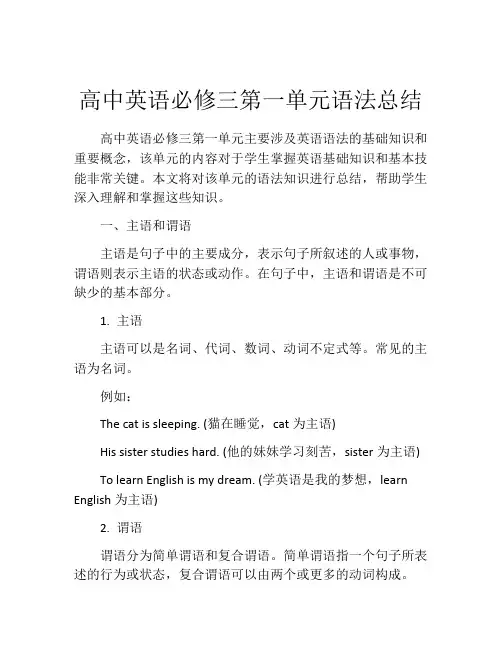
高中英语必修三第一单元语法总结高中英语必修三第一单元主要涉及英语语法的基础知识和重要概念,该单元的内容对于学生掌握英语基础知识和基本技能非常关键。
本文将对该单元的语法知识进行总结,帮助学生深入理解和掌握这些知识。
一、主语和谓语主语是句子中的主要成分,表示句子所叙述的人或事物,谓语则表示主语的状态或动作。
在句子中,主语和谓语是不可缺少的基本部分。
1. 主语主语可以是名词、代词、数词、动词不定式等。
常见的主语为名词。
例如:The cat is sleeping. (猫在睡觉,cat为主语)His sister studies hard. (他的妹妹学习刻苦,sister为主语)To learn English is my dream. (学英语是我的梦想,learn English为主语)2. 谓语谓语分为简单谓语和复合谓语。
简单谓语指一个句子所表述的行为或状态,复合谓语可以由两个或更多的动词构成。
例如:Ann is walking in the park. (Ann正在公园里散步,is walking 为简单谓语)John has been studying English for three years. (John已经学英语三年,has been studying为复合谓语)二、时态和语态时态用来表示动作、状态或存在的时间,包括现在时、过去时、将来时三种;语态用来表示句子的主语是做什么的,分为主动语态和被动语态两种。
1. 时态现在时:表示现在正在进行的动作或状态。
例如:She is reading a book. (她正在看书。
)过去时:表示过去发生的动作或状态。
例如:He went to the cinema yesterday. (他昨天去了电影院。
)将来时:表示将来要发生的动作或状态。
例如:I will go to Beijing next month. (下个月我要去北京。
)2. 语态主动语态:强调主语是动作的执行者。

《高中英语(上外版)》必修第三册Unit 1 Road to Success课时:第3课时课题:Grammar in Use课型:语法课教学设计与说明一.学情分析本节课授课对象为高一第二学期的学生。
经过第一学期的学习,同学们已经有了分词在句子中各项功能的总体概念。
但是大部分同学们对分词各项句法功能的总体框架结构是不清晰的,对分词的各项句法功能各自的特点、重点、难点没有概念。
所以需要帮助学生分项理清特点、重点、难点,并在语言实际交际运用中加以操练并巩固。
二.教材分析单元语法运用Grammar in Use聚焦于分词作补语(宾语补足语和主语补足语)的复习和巩固。
教材P9-10上有三道语法练习题。
第一题旨在分析分词在句子中的功能,认识分词做补语的结构。
第二题旨在辨认分词作补语的结构并能正确区分这一结构中现在分词和过去分词在做补语时的区别。
第三题考查语言的综合运用能力,要求学生在语篇中、在上下文语境中理解、分析、归纳并灵活运用分词作补语这一语法功能,同时要求学生区分分词作补语与分词其它功能的区别。
三.教学设计思路本课为本单元语法教学的第二课时:语法练习课,旨在帮助学生在第一节语法课的基础上复习巩固分词作补语这一语法功能,并为学生创设产出的机会,提高语用能力。
导入部分利用课本P8-9练习I&II,采用归纳演绎教学法复习第一课时学习过的内容,引导学生学会对学过的语法规则进行分类归纳,在头脑中形成非谓语知识体系的网络架构。
操练部分采用任务型教学方法,在遵循学生认知规律的基础上设置多层次能力要求逐步递进的实践任务,引导学生在完成各个层次的任务中逐步实现分词做补语这一语法功能的内化,并在任务中实现learning by using, learning for using的语法学习目标。
Lesson Plan(the 3 period)rdLearning Objectives:By the end of the period, the students are expected to:1. have the ability of classifying and summarizing grammar rules of -ing / -ed forms as complements;2. form the network of -ing / -ed forms as complements in mind so as to distinguish them from other functions of -ing / -ed forms;3. skillfully apply -ing / -ed forms as complements in listening, reading and writing.Learning Procedures:Step I. Revision (Interactive activity)*T: Help the students recall and classify what they learned in the first period of Grammar in Use with the help of Exercise I & II on P 8-9.*Ss: Recall the grammatical rules of -ing / -ed forms used as complements by category.I. -ing form used as complements:feel / hear / listen to / see / watch / look at / notice / observe ... + O. + doing (O. C.)S.+ be felt / heard ... + doing (S. C.)discover / find / smell / catch ... + O. doing (O. C.)S. + be + discovered ... + doing (S. C.)get / have / keep / leave / send / set / start ... + O. doing (O. C.)with + O. + doing (O. C.)II. -ed form used as complements:see / hear / watch / find / feel / consider ...+ O. + done (O. C.)S.+ be seen ... + done (S. C.)get / have / keep / leave / make ... + O. + done (O. C.)declare / like / need / order / want / wish ... + O. + done (O. C.)with + O. + done (O. C.)Note: After working non-stop for twenty hours, he went to bed tired and hungry. (O. C.) The athlete went away quite satisfied with the result of the match. (O.C.)Step II. PracticeI. Identify - ing /- ed forms as complements in the lyrics (Task 1)*T: Play the song “Those Sweet Words” and ask students to identify - ing /- ed forms as complements in the lyrics while enjoying the melody. And then focus on the functions of -ing / -ed forms in “Iknow I saw you saying it.” and “I just h ave to hear t hose sweet words s poken like a melody.” and the meanings of the two sentences.*Ss: Identify - ing /- ed forms as complements and translate the two sentences into Chinese.Those Sweet WordsBy Norah JonesWhat did you sayI know I saw you saying itMy ears won't stop ringingLong enough to hearThose sweet wordsWhat did you sayAnd now the dayThe hour hand has spunBefore the night is doneI just have to hearThose sweet wordsSpoken like a melodyAll your love...II. Apply -ing / -ed forms as complements in individual sentences. (Task 2)*T: Ask students to identify the structure of -ing / -ed forms as complements in the following sentences and then fill in the blanks with proper forms of the verbs given in the box. Call students’attention to the differences between -ing forms as complements and -ed forms as complements.*S: Read the sentences silently and underline the structure of -ing / -ed forms as complements in each sentence and then fill in the blanks with -ing forms or -ed forms based on grammar rules of the differences between -ing forms as complements and -ed forms as complements.III. Apply -ing / -ed forms as complements in a passage. (Task 3)*T: Ask students to read a short passage and fill in the blanks with the -ing / -ed forms of the verbs given in the box. Then circle the ones that are used as complements. Call students’ attention to the differences between -ing / -ed forms as complements and -ing / -ed forms for other functions.*S: Read the short passage silently and circle the structures of -ing / -ed forms as complements in the passage and then fill in the blanks with -ing forms or -ed forms based on grammar rules of the differences between -ing / -ed forms as complements and -ing / -ed forms for other functions.IV. Apply -ing / -ed forms as complements in writing sentences. (Task 4)*T: Ask students to read each sentence in Chinese carefully and make out which category of -ing / -ed forms as complements fits the contexts best based on the given word in the brackets. And then translate the whole sentence into English.*S: First, make out and write down the proper structure of -ing / -ed forms as complements. Then, translate the whole sentence into English.。

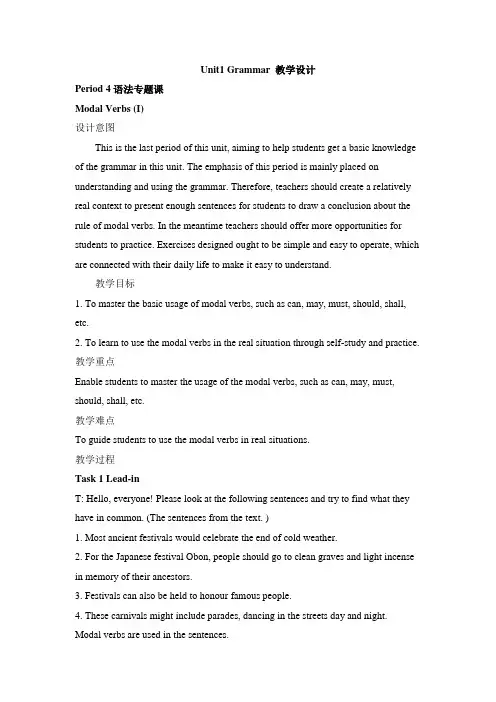
Unit1 Grammar 教学设计Period 4语法专题课Modal Verbs (I)设计意图This is the last period of this unit, aiming to help students get a basic knowledge of the grammar in this unit. The emphasis of this period is mainly placed on understanding and using the grammar. Therefore, teachers should create a relatively real context to present enough sentences for students to draw a conclusion about the rule of modal verbs. In the meantime teachers should offer more opportunities for students to practice. Exercises designed ought to be simple and easy to operate, which are connected with their daily life to make it easy to understand.教学目标1. To master the basic usage of modal verbs, such as can, may, must, should, shall, etc.2. To learn to use the modal verbs in the real situation through self-study and practice. 教学重点Enable students to master the usage of the modal verbs, such as can, may, must, should, shall, etc.教学难点To guide students to use the modal verbs in real situations.教学过程Task 1 Lead-inT: Hello, everyone! Please look at the following sentences and try to find what they have in common. (The sentences from the text. )1. Most ancient festivals would celebrate the end of cold weather.2. For the Japanese festival Obon, people should go to clean graves and light incense in memory of their ancestors.3. Festivals can also be held to honour famous people.4. These carnivals might include parades, dancing in the streets day and night. Modal verbs are used in the sentences.(设计意图: 通过课文句子导入新课,让学生初次体会情态动词的使用语境,同时带着问题进入课堂,激发学生兴趣。
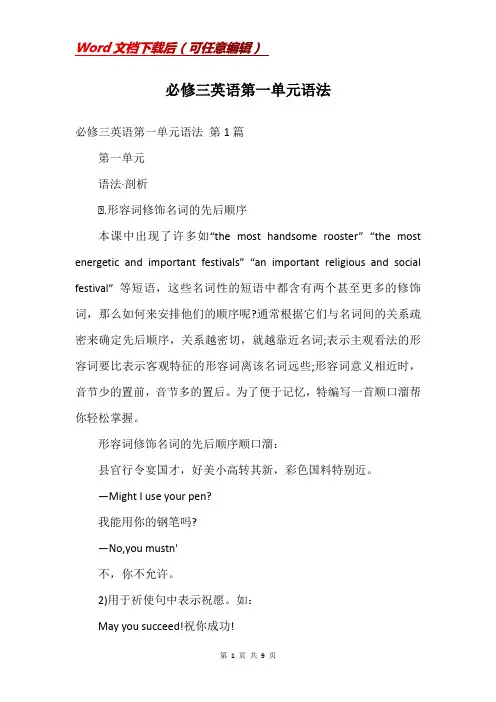
必修三英语第一单元语法必修三英语第一单元语法第1篇第一单元语法·剖析Ⅰ.形容词修饰名词的先后顺序本课中出现了许多如“the most handsome rooster” “the most energetic and important festivals” “an important religious and social festival” 等短语,这些名词性的短语中都含有两个甚至更多的修饰词,那么如何来安排他们的顺序呢?通常根据它们与名词间的关系疏密来确定先后顺序,关系越密切,就越靠近名词;表示主观看法的形容词要比表示客观特征的形容词离该名词远些;形容词意义相近时,音节少的置前,音节多的置后。
为了便于记忆,特编写一首顺口溜帮你轻松掌握。
形容词修饰名词的先后顺序顺口溜:县官行令宴国才,好美小高转其新,彩色国料特别近。
—Might I use your pen?我能用你的钢笔吗?—No,you mustn'不,你不允许。
2)用于祈使句中表示祝愿。
如:May you succeed!祝你成功!和have to的用法1)表示必须、必要。
回答must引出的问句时,如果是否定的回答,不能用mustn't,而要用needn't或don't have to。
如:—Must we hand in our English exercise books?我们必须交英语作业吗?—Yes,you (No,you don't have )是的,你必须要交。
(不,你不必)。
2)have to的含义与must相似,两者往往可以互换使用,但must 与have to有下列几点不同:?①must表示的是说话人的主观看法,而have to则往往强调客观需要。
②must只有一种形式,have则涉及人称、时态等方面的变化形式。
③二者的否定意义不大相同。
如:You mustn't (带有很强的语气,表示“禁止、不允许”)你不许走。
GRAMMAR情态动词(一)【观察】请仔细观察下列句子中情态动词的用法,并归纳总结。
1. ①Even top students can make mistakes in exams.②Anna may know Tom’s address.③If you’re not careful, you could get into trouble.④Do you think Mr. Smith might be here on time?⑤—It must be our headmaster.—No, it can’t be him. He has gone to Beijing. It may be Mr. Zhang.⑥The rescue team should arrive by 5 o’clock this afternoon.2. ①She can speak five languages.②I couldn’t get tickets; they were sold out.3. ①You can have my seat. I’m going now.②Could I have a drink of water, please?③—May I smoke here?—Yes, of course.④Will / Would you please lend me your car tonight?⑤Shall we go out and have a walk after dinner?⑥Shall Tom go there with me tomorrow?4. ①Ask, if you will, who the owner is.②I would ask such questions when I was at school.5. ①You shall be punished if you break the rule.②Tell her that she shall have the bike tomorrow.6. ①We should take good care of our children.②You should give up smoking and drinking.7.①All passengers must wear seat belts.②You mustn’t move any of the books in my bag.【自我归纳】1. can / could, may / might, must / can’t, should都可表示可能性。